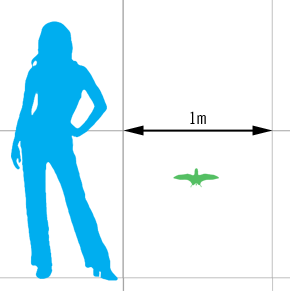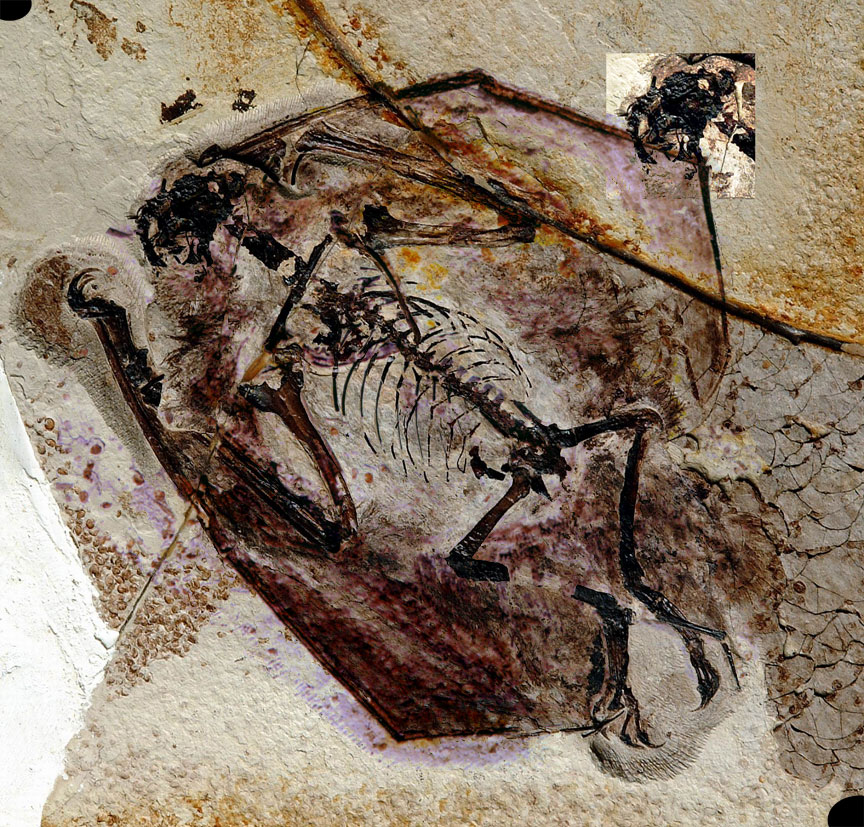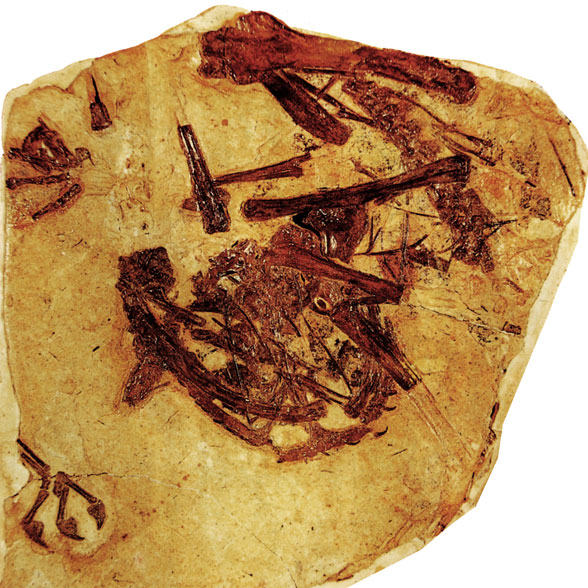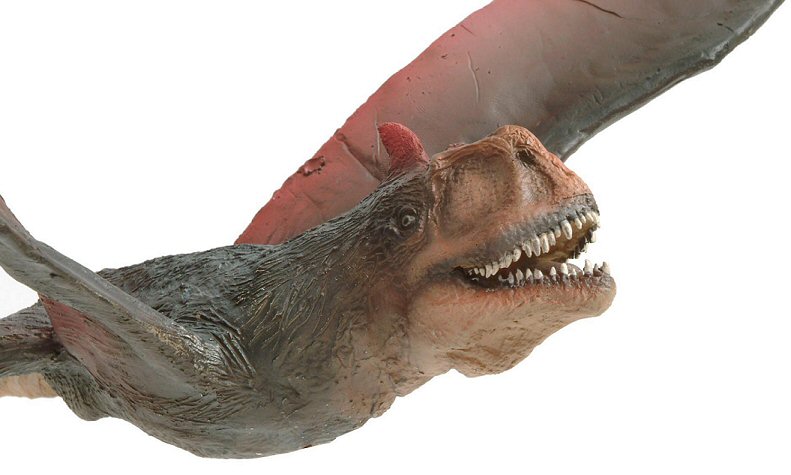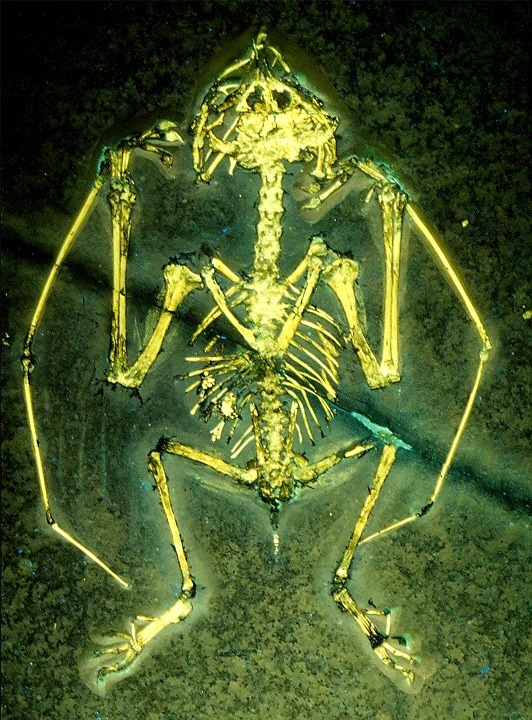[Recent Entries][Archive][Friends][User Info]
Below are the 4 most recent journal entries recorded in the "Сообщество, посвящённое ра" journal:| May 17th, 2014 | |
|---|---|
| 01:52 pm [industrialterro] [Link] |
Dendrorhynchoides Dendrorhynchoides was a genus of anurognathid pterosaur containing species known from the Early Cretaceous (early Aptian) Yixian Formation, discovered near Beipiao, Chaoyang, Liaoning, China, and from Middle Jurassic Tiaojishan Formation of Qinglong, northern Hebei Province, China. The holotype of the type species was found in the Jianshangou Bed of the Yixian Formation, dated to about 124.6 million years old. However, Lü and Hone (2012) considered it possible that the holotype of D. curvidentatus was actually found in the Middle Jurassic deposits; the authors note that all other Chinese anurognathids are Jurassic in age, and that Jeholopterus was also initially thought to be a Cretaceous taxon until subsequent studies established it to be from the Jurassic. The genus was in 1998 first named Dendrorhynchus by Ji Shu'an and Ji Qiang, but that name proved to be preoccupied by a nemertean parasitic worm named in 1920 by David Keilin. It was therefore renamed in 1999. The type species is Dendrorhynchoides curvidentatus. The genus name is derived from Greek dendron, "tree" and rhynkhos, "snout" in reference to it being assumed a tree-dweller and presumed a close relative of Rhamphorhynchus. The specific name means "curved-toothed" in Latin. A second species, D. mutoudengensis, was described in 2012. The genus is based on holotype GMV2128, a fossil originally discovered around 1995 and obtained by science from illegal fossil dealers who first prepared it. It consists of a near-complete skeleton of a subadult individual and is crushed. Most elements are present, exceptions include the sternum, the tail end, sacrals and the fourth phalanx of the wing finger. Of the type specimen, most parts of the skull have become detached so that its shape is difficult to determine, but it was generally short and broad. Eleven teeth have been preserved scattered throughout the matrix, that are recurved with a broader base and have a length of three millimetres. The authors identified lower jaws with a preserved length of fifteen millimetres. The cervical vertebrae are short and broad. Six dorsal vertebrae have been preserved, nine ribs and six belly ribs at the left side. The tail has a preserved length of five centimetres, but part of this is accounted for by a section that might have been added to enhance the value of the fossil. The tail vertebrae at the base, the authenticity of which is certain, are short. The wings are relatively short. The humerus is robustly built but elongated with a length of 27 millimetres. The ulna is 35.5 millimetres long. The metacarpals are short with seven millimetres length for the first three, 9.3 millimetres for the fourth wing-bearing metacarpal. The first three fingers are well developed with the first having an elongated first phalanx. They bear short but sharp claws. The first phalanx of the fourth, wing, finger has a length of 44.5, the second of 35.6 millimetres. The size of the third cannot be established because of damage. A short and slender pteroid, 5.9 millimetres long, points towards the elbow. The wingspan is about forty centimetres, making Dendrorhynchoides one of the smallest known pterosaurs The tibia has a length of 26.7 millimetres and is about a third longer than the femur. The fibula is reduced, reaching about half-way downwards along the tibia shaft. The foot is long with the metatarsals having a length of 12.1 millimetres. The fifth toe is elongated. Because of the presumed long tail, the authors rejected a placement within the Anurognathidae and classified it instead as a long-tailed rhamphorhynchid, mainly in view of the general long bone proportions. It was in 2000 identified as an anurognathid, and it was confirmed that the fossil had been doctored prior to its description. A cladistic analysis by Alexander Kellner in 2003 had the same outcome, Dendrorhynchoides being found to form an anurognathid clade with Batrachognathus and Jeholopterus, that he named the Asiaticognathidae. An analysis by Lü Junchang in 2006 resolved the relations even further, finding Dendrorhynchoides to be the sister taxon of clade formed by the other two asiaticognathid species. The describers postulated a tree-dwelling lifestyle for Dendrorhynchoides as an insectivore. In 2010 a second specimen, of a juvenile, was announced, that proved that a more elongated tail was present after all, albeit not so long as the faked tail of the holotype: about 85% of femur length. This specimen eventually was designated as the holotype of Dendrorhynchoides mutoudengensis. The specimen was originally stored in the Guilin Geological Museum and designated GLGMV 0002; later it was moved to the Jinzhou Paleontological Museum and designated JZMP-04-07-3. Размеры тела в сравнении с человеком:
Tags: Вымершие рептилии, Мел, авеметатарзалии, анурогнатиды, архозавроморфы, архозавры, диапсиды, птерозавры, рамфоринхоидеи |
| May 22nd, 2012 | |
| 07:39 pm [industrialterro] [Link] |
Jeholopterus Jeholopterus was a small anurognathid pterosaur from the Daohugou Beds of northeastern China (of uncertain age, probably Middle or Late Jurassic), between 168 and 152 million years ago), preserved with hair and skin remains. The type species is based on holotype IVPP V12705, a nearly complete specimen from the Daohugou beds of Ningcheng County in the Neimongol (Inner Mongolia) Autonomous Region of China. The specimen is crushed into a slab and counterslab pair, so that parts of the specimen are preserved on one side of a split stone and some on the other. This includes exquisite preservation of carbonized skin fibers and, arguably, "hair" or "protofeathers." The fibers are preserved around the body of the specimen in a "halo." Wing tissue is preserved, though its extent is debatable, including the exact points of attachment to the legs (or if it attached to the legs at all). In 2009 Alexander Kellner published a study reporting the presence of three layers of fibres in the wing, allowing the animal to precisely adapt the wing profile. As an anurognathid, Jeholopterus shows the skull form typical for this group, being wider than it was long (28 mm), with a very broad mouth. Most teeth are small and peg-like, but some are longer and recurved. The neck was short with seven or eight cervical vertebrae. Twelve or thirteen dorsal vertebrae are present and three sacrals. There are five pairs of belly ribs. The tail vertebrae have not been preserved. The describers argue that Jeholopterus had a short tail, a feature seen in other anurognathids but unusual for "rhamphorhynchoid" (i.e. basal) pterosaurs that typically have a long tail. Wang et al. cited the presence of a fringe of hair in the region of the tail to infer the presence of a short tail. However, a subsequent study by Dalla Vecchia argued that gleaning any information about the tail is impossible, given that the tail is "totally absent" in the fossil. The wing bones are robust. The metacarpals are very short. A short pteroid, supporting a propatagium, is pointing towards the body. The hand claws are long and curved. The wings of Jeholopterus show evidence that they attached to the ankle, according to Wang et al.. They are relatively elongated with a wingspan of ninety centimetres. The legs are short but robust. The toes bear well-developed curved claws, but these are not as long as the hand claws. The fifth toe is elongated, according to the authors supporting a membrane between the legs, the uropatagium. Jeholopterus was by the authors assigned to the Anurognathidae. In 2003 a cladistic analysis by Kellner found it to be a member, together with Dendrorhynchoides and Batrachognathus of an anurognathid clade Asiaticognathidae. An analysis by Lü Junchang in 2006 resolved its position as being the sister taxon of Batrachognathus. Далее идёт пятиминутка острого, запущенного хумора: Though he never examined the fossil himself, advertising artist David Peters has popularized his idiosyncratic opinions about Jeholopterus and other pterosaurs widely on the internet. In general he finds and illustrates hosts of ornamental features and even multiple embryos although no other researchers have ever confirmed his findings. By manipulating downloaded images of Jeholopterus in the computer art program Photoshop, David Peters (2003) reported that he discovered an unusual suite of soft-tissue remains, including a horse-like tail Peters speculated may have been used as a fly sweeper/distractor, as well as a long fly lure (similar to that of the anglerfish) protruding from the head, and a fin or series of fins along the back. Peters also reported that he had found "rattlesnake-like fangs", and these, along with what he described as a rattle-snake-like mandible, buttressed palate, "surgically-sharp" unguals, robust limbs and other characters suggested that Jeholopterus was a vampire pterosaur adapted to plunging fangs into tough hide, then rotating the skull forward locking the fangs beneath the hide to improve adhesion. The small teeth of the lower jaw would not have penetrated but squeezed the wound like a pliers. Prominent pterosaur researcher Chris Bennett has described Peters' findings as "fantasy" and has vehemently denounced his methodology.
Tags: Вымершие рептилии, Юра, авеметатарзалии, анурогнатиды, архозавроморфы, архозавры, диапсиды, птерозавры, рамфоринхоидеи |
| May 9th, 2012 | |
| 04:01 pm [industrialterro] [Link] |
Batrachognathus Batrachognathus is an extinct genus of "rhamphorhynchoid" pterosaur from the Late Jurassic (Oxfordian - Kimmeridgian) Karabastau Svita of the central Asian republic of Kazakhstan. The genus was named in 1948 by the Russian paleontologist Anatoly Nicolaevich Ryabinin. The type species is Batrachognathus volans. The genus name is derived from Greek batrakhos, "frog" and gnathos, "jaw", in reference to the short wide head. The specific epithet means "flying" in Latin. Three fossils have been found in a lacustrine sediment in the North-West Tien Shan foothills of the Karatau Mountains. In the Jurassic this area had some similarities in habitat to the Solnhofen lagoon deposits in Bavaria, Germany. The genus is based on holotype PIN 52-2, an incomplete and disarticulated skeleton consisting of skull fragments, jaws, vertebrae, ribs, legs and wing bones. The skull of 48 mm long is high, short and broad. The upper jaws have in total 22 or 24 recurved conical teeth; with the lower jaws they make a short and very wide mouth. The animal is not preserved with a tail. Whether it had one is debatable; usually it is assumed a short tail was present. The wingspan has been estimated at 50 cm; David Unwin in 2000 gave a higher estimate of 75 cm. Batrachognathus was assigned to the Anurognathidae, as a relative of Anurognathus. In 2003 it was joined with the Asian anurognathids Dendrorhynchoides and Jeholopterus in a clade Asiaticognathidae by Alexander Kellner. According to an analysis in 2006 by Lü Junchang Batrachognathus and Jeholopterus were sister taxa. Like all anurognathids Batrachognathus is assumed to have been an insectivore, catching insects on the wing with its broad mouth.
Tags: Вымершие рептилии, Юра, авеметатарзалии, анурогнатиды, архозавроморфы, архозавры, диапсиды, птерозавры, рамфоринхоидеи |
| 03:23 pm [industrialterro] [Link] |
Anurognathus Анурогнат (Anurognathus от греч. αν — без, греч. оυρα — хвост и греч. γναθος — челюсти) — род малых птерозавров семейства Anurognathidae, представители которого жили около 150 миллионов лет назад в конце юрского периода. Род был описан и назван Людвигом Дёдерляйном (Ludwig Döderlein) в 1923 году. Типовым видом является Anurognathus ammoni. Представители рода отличаются необычной внешностью по отношению к другим птерозаврам подотряда Рамфоринхоиды. Видовое название ammoni дано в честь баварского геолога Людвига фон Аммона, который собрал коллекцию ископаемых, в которой был и Anurognathus ammoni. Анурогнат означает буквально «бесхвостый» или «беззубый» — что ж, вполне понятная, хотя и не совсем точная характеристика применительно к этим необычным птерозаврам. Судить об анурогнатах ученым остаётся только по останкам одной-единственной особи, обнаруженной в Германии в 20-е годы XX века. Хвост у него и правда походил на обрубок, голова была маленькая и тупорылая, а в пасти имелось всего несколько мелких зубов. Зато анурогнаты обладали хорошо развитыми конечностями. Впрочем, наличие таких признаков объясняется тем, что найденные останки принадлежали молодой особи, — у взрослого животного они наверняка были бы другими. Кроме того, анурогнаты, возможно, принадлежали к легким охотникам, и добычей им служили стрекозы и прочие насекомые, которых они отлавливали, прыгая со спин динозавров, используя их как живые трамплины. В размахе крыльев достигали 50 см. Anurognathus had a short head with pin-like teeth for catching insects and although it traditionally is ascribed to the long-tailed pterosaur group "Rhamphorhynchoidea", its tail was comparatively short, allowing it more maneuverability for hunting. According to Döderlein the reduced tail of Anurognathus was similar to the pygostyle of modern birds. Its more typical "rhamphorhynchoid" characters include its elongated fifth toe and short metacarpals and neck. With an estimated wingspan of fifty centimetres (20 inches) and a nine centimetre long body (skull included), its weight was limited: in 2008 Mark Paul Witton estimated a mass of forty grammes for a specimen with a 35 centimetre wingspan. The holotype was redescribed by Peter Wellnhofer in 1975. Later a second, smaller, specimen was found, probably of a subadult individual. Its slab and counterslab are separated and both were sold to private collections; neither has an official registration. It was described by S. Christopher Bennet in 2007. This second exemplar is much more complete and better articulated. It shows impressions of a large part of the flight membrane and under UV-light remains of the muscles of the thigh and arm become visible. It provided new information on many points of the anatomy. The skull was shown to have been very short and broad, wider than long. It transpired that Wellnhofer had incorrectly reconstructed the skull in 1975, mistaking the large eye sockets for the fenestrae antorbitales, skull openings that in most pterosaurs are larger than the orbits but in Anurognathus are small and together with the nostrils placed at the front of the flat snout. The eyes pointed forwards to a degree, providing some binocular vision. Most of the skull consisted of bone struts. The presumed pygostyle was absent; investigating the real nine tail vertebrae instead of impressions showed that they were unfused, though very reduced. The wing finger lacked the fourth phalanx. According to Bennett a membrane, visible near the shin, showed that the wing contacted the ankle and was thus rather short and broad. Bennett also restudied the holotype, interpreting bumps on the jaws as an indication that hairs forming a protruding bristle were present on the snout. The Anurognathidae were a group of small pterosaurs, with short tails or tailless, that lived in Europe and Asia during the Jurassic and early Cretaceous periods. Four genera are known: Anurognathus, from the Late Jurassic of Germany, Jeholopterus, from the Middle or Late Jurassic of China, Dendrorhynchoides, from the Early Cretaceous of China, and Batrachognathus, from the Late Jurassic of Kazakhstan. Bennett (2007) claimed that the holotype of Mesadactylus, BYU 2024, a synsacrum, belonged to an Anurognathid. Mesadactylus is from the Late Jurassic Morrison Formation of the USA. Indeterminate Anurognathid remains have also been reported from the Middle Jurassic Bakhar Svita of Mongolia. A family Anurognathidae was named in 1928 by Franz Nopcsa von Felső-Szilvás (as the subfamily Anurognathinae) with Anurognathus as the type genus. The family name Anurognathidae was first used by Oskar Kuhn in 1967. Both Alexander Kellner and David Unwin in 2003 defined the group as a node clade: the last common ancestor of Anurognathus and Batrachognathus and all its descendants. The phylogeny of the Anurognathidae is uncertain. Some analyses, as those of Kellner, place them very basal in the pterosaur tree. However, they do have some characteristics in common with the derived Pterodactyloidea, such as the short and fused tail bones. In 2010 an analysis by Brian Andres indicated the Anurognathidae and the Pterodactyloidea were sister taxa. This conforms better to the fossil record because no early anurognathids are known and would require a ghost lineage of over sixty million years.
Репродукции (1, 2, 3, 4, 5, 6, 7, 8, 9, 10):
( Далее )
Tags: Вымершие рептилии, Юра, авеметатарзалии, анурогнатиды, архозавроморфы, архозавры, диапсиды, птерозавры, рамфоринхоидеи |



